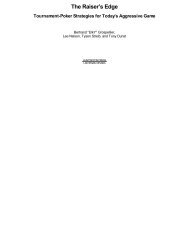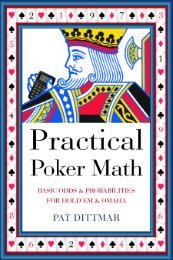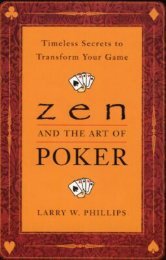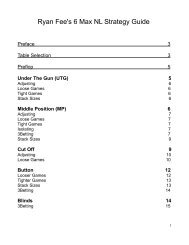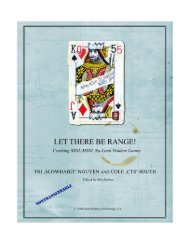You also want an ePaper? Increase the reach of your titles
YUMPU automatically turns print PDFs into web optimized ePapers that Google loves.
Hero: A♠2♥<br />
Villain: A♣7♦<br />
Board: A♥Q♦6♣3♠<br />
You’re behind since his 7 kicker plays. How many outs do you<br />
have? Well, you certainly have the three 2s left to give you two<br />
pair. So, that’s three outs to a win. However, what happens if<br />
the river is a 3? At that point you have AA33Q, and so does<br />
your opponent! You tie and will chop the pot. So, you have<br />
three outs to a chop with the 3s. The same is true if the river is a<br />
6. You will have AA66Q, and so will he. This is another chop.<br />
You have now have a total of six outs to a chop. What if the<br />
river is a Q? Think carefully. At this point, you’ll have<br />
AAQQ6; however, your opponent has AAQQ7, so he wins. His<br />
7 now plays, and he has you outkicked. So, in this hand you<br />
have three outs to a win, and six outs to a chop.<br />
When you have the worst hand and are trying to hit an out, it’s<br />
called drawing. You’re on a draw. Table 4 shows common<br />
draws and the number of outs to a better hand than you currently<br />
hold.<br />
Table 4. Common draws.<br />
Draw Outs<br />
Gutshot (aka Gutter or Belly Buster) 4<br />
Pair (not pocket pair) 5<br />
Open-Ended Straight Draw (OESD) 8<br />
Double Gutter (aka Double Belly Buster) 8<br />
Four-flush (aka Flush Draw) 9<br />
Open-Ended Straight Flush Draw (OESFD) 15<br />
41





